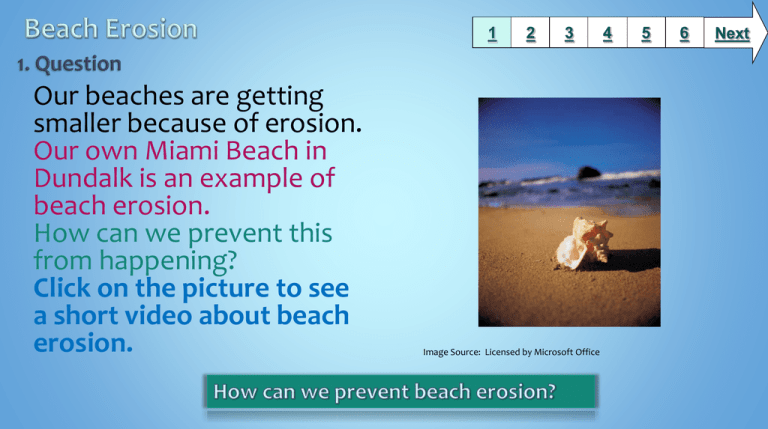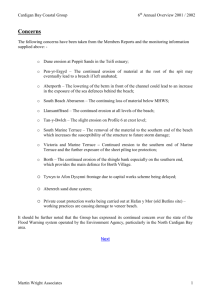
1
Our beaches are getting
smaller because of erosion.
Our own Miami Beach in
Dundalk is an example of
beach erosion.
How can we prevent this
from happening?
Click on the picture to see
a short video about beach
erosion.
2
3
Image Source: Licensed by Microsoft Office
4
5
6
Next
1
2
3
4
5
6
Next
What is erosion?
BrainPOP Jr
*NOTE: Go to the BCPS Database page and click on BrainPOP Jr., then return to this
slide and click on the video link above.
PBS Kids
Pictures of weathering and erosion
What do engineers use to repair and prevent erosion?
Jetties
Groins and Breakwaters
Geo Tubes
Coconut Coir Logs
*See link in Teacher Resources for You Tube video
Click on the pictures for videos about beach erosion.
Image Source: NBC Learn
1
2
3
4
5
As you view the resources on
Slide 2, you should be thinking
about:
*What methods have been used
to prevent beach erosion?
*Which methods have been
most successful?
Use this organizer for your
information.
Image Source: by subscription ClipArt.com
6
Next
1
2
3
Now that you have seen some
methods to prevent beach
erosion, choose one!
Draw a diagram or picture to
describe it.
Complete a chart that tells the
Pros and Cons of that
method.
Use this checklist to make sure
your work is complete
Click here!!
4
5
6
Next
1
Erosion experiment
2
3
4
6
Make your own sand dune
Image Source: by permission from Education.com
Image Source: by subscription from ClipArt.com
5
Next
1
Grade 2 Science
BCPS Curriculum / Maryland State Curriculum/Next Generation Science Standards
2-ESS-2.1 Compare multiple solutions designed to slow or prevent wind or water from changing the
shape of the land.
Common Core State Standards
Reading: 1. Read closely to determine what the text says explicitly and to make logical inferences from it;
cite specific textual evidence when writing or speaking to support conclusions drawn from the text.
Writing: 7. Conduct short as well as more sustained research projects based on focused questions,
demonstrating understanding of the subject under investigation.
Standards for the 21st Century Learner
1.1.6 Read, view, and listen for information presented in any format (e.g. textual, visual, media, digital) in
order to make inferences and gather meaning.
2.1.3 Use strategies to draw conclusions from information and apply knowledge to curricular areas, realworld situations, and further investigations.
ISTE NETS - National Educational Technology Standards for Students
3. Research and Information Fluency: Students apply digital tools to gather, evaluate, and use information.
b. Locate, organize, analyze, evaluate, synthesize, and ethically use information from a variety of
sources and media.
4. Critical Thinking, Problem Solving, and Decision Making: Students use critical thinking skills to plan and
conduct research, manage projects, solve problems, and make informed decisions using appropriate
digital tools and resources. c. Collect and analyze data to identify solutions and/or make informed
decisions.
2
3
4
5
6
Time Frame: 1-2 class periods
Differentiation strategies for this lesson:
Direct students to use learning tools included in our BCPSlicensed databases, such as: audio read-aloud, labeled reading
levels/Lexiles, and embedded dictionaries.
Use Closed Captioning on videos
Allow students to work in partners or jigsaw materials
Learning Styles addressed in this lesson:
Visual, Auditory, Kinesthetic, Field Dependent, Field Independent
Notes to the teacher:
Collaborate with your school library media specialist to
implement this lesson.
This is the link to the You Tube Video on engineering projects, It
can only be viewed under a teacher log in.
For the Safari Video on Slide 1, students may need to log in using
their internal password, or teacher may choose to show the video in a
group setting.
Last updated: July 2014
Created by Linda Brown, Library Media Specialist
BCPS Slam Dunk Research Model, Copyright 2013, Baltimore County Public Schools, MD, all rights reserved. The models may be used for educational, non-profit school use only.
All other uses, transmissions, and duplications are prohibited unless permission is granted expressly. This lesson is based on Jamie McKenzie’s Slam Dunk Lesson module.







